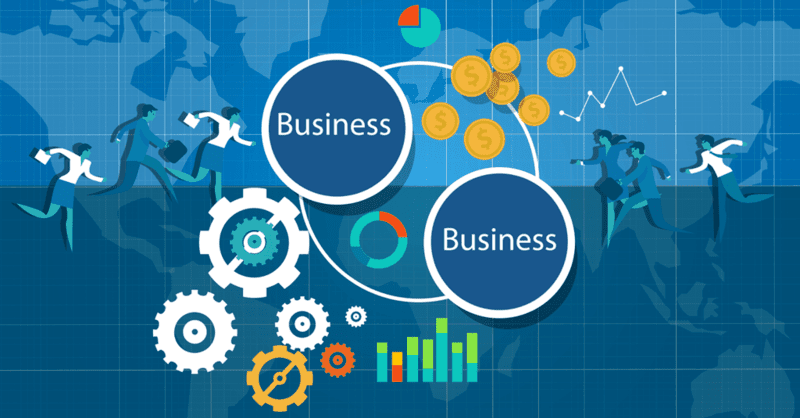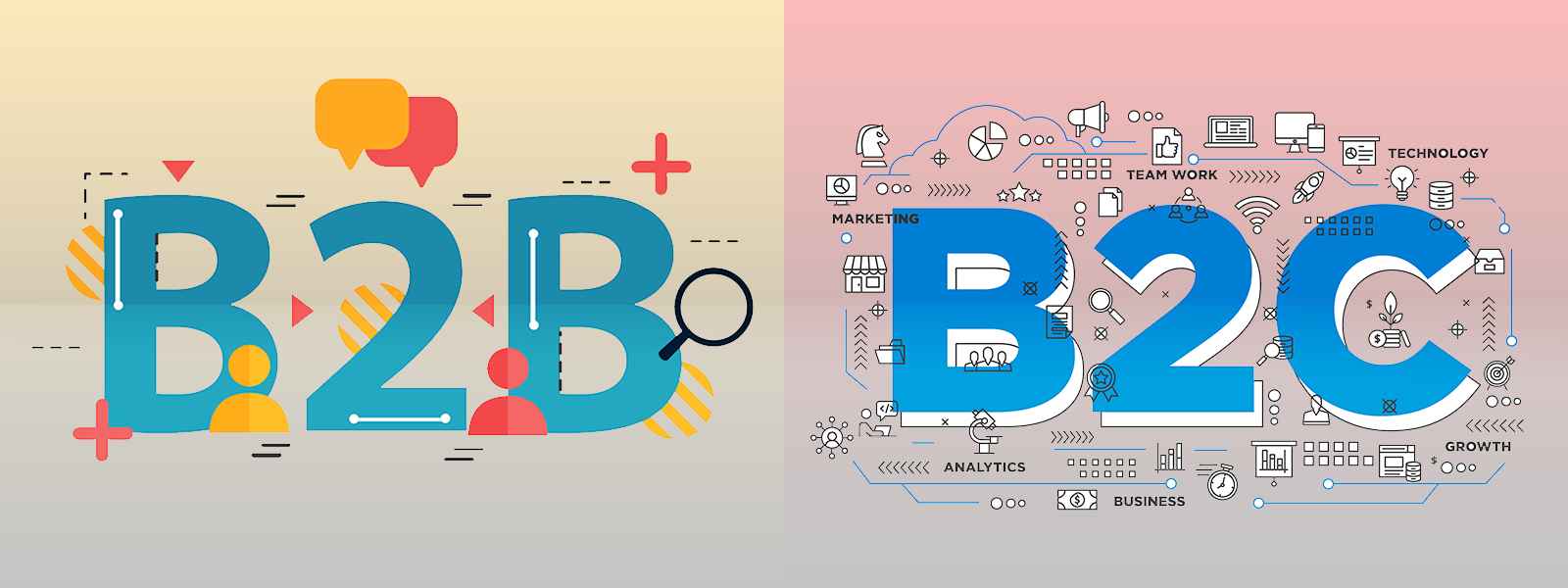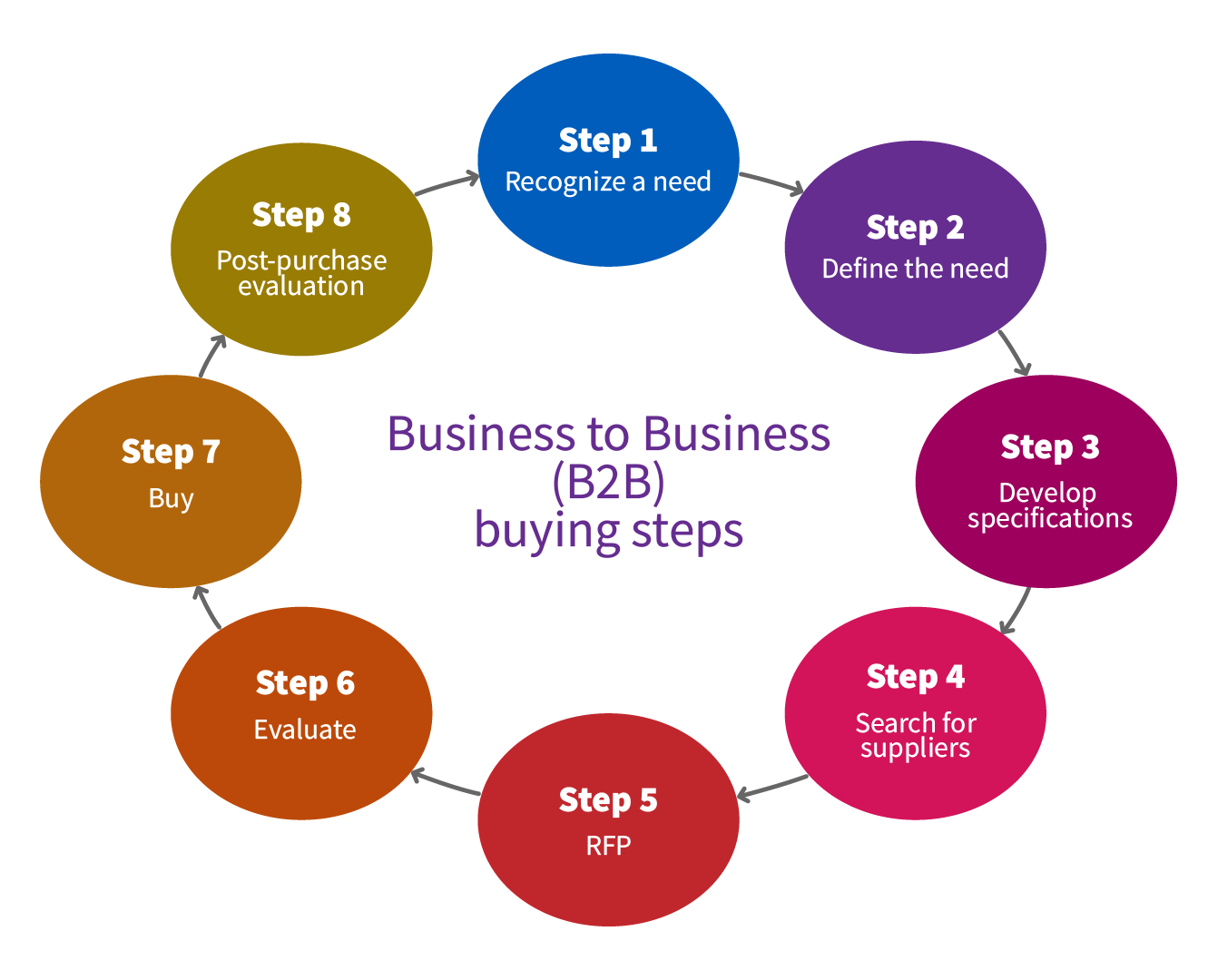What Is the B2B Sales Process? 8 Standard Steps for Maximum Efficiency
Discover the B2B sales process and the 8 crucial steps to achieve maximum efficiency. From setting goals to developing strategies and implementing marketing tactics, learn how to optimize your sales process to increase sales and build long-lasting customer relationships.

1. What Is the B2B Sales Process?
The B2B (Business-to-Business) sales process is a systematic series of activities and steps undertaken by a business to sell its products or services to other businesses. Unlike B2C (Business-to-Consumer) sales, B2B sales are often more complex and require more steps because the customers are organizations or companies with detailed purchasing processes and specific requirements. This process typically includes setting sales goals, researching and identifying potential customers, analyzing customer needs, developing a sales strategy, building a marketing list, implementing the strategy, monitoring performance, and finally, optimizing and adjusting the strategy based on the results. Each step in this process plays a crucial role in ensuring the effectiveness and success of B2B sales activities.

2. The Importance of Building a B2B Sales Process
Building a B2B sales process is of paramount importance for any business that wants to succeed in a competitive market. A well-designed B2B sales process helps a business better understand the needs and desires of its potential customers, leading to more effective outreach and sales strategies. It not only helps optimize resources and time but also improves the customer experience, strengthens long-term relationships, and creates sustainable value for both parties. Having a clear and systematic process also helps the sales team work more efficiently, minimizes errors, and ensures consistency in all sales activities. Furthermore, this process provides crucial data for the business to continuously evaluate and improve its sales strategy, thereby achieving revenue growth and sustainable development goals.

3. Key Differences Between B2B and B2C Sales Processes
Below is a comparison table between the B2B (Business-to-Business) and B2C (Business-to-Consumer) sales processes:
Criteria | B2B Sales Process | B2C Sales Process |
Target Audience | Businesses, organizations | Individual consumers |
Transaction Value | Typically higher, large transactions | Typically lower, small transactions |
Decision-Making Process | Complex, involves multiple parties, decisions based on many economic factors | Simpler, often an individual decision |
Sales Cycle | Usually longer, can last from several months to years | Usually shorter, can be completed in a few minutes to a few days |
Customer Relationship | Focus on building long-term and sustainable relationships | Often short-term, focused on immediate purchase experience |
Approach Method | Approaches through professional channels like email, conferences, direct calls | Approaches through direct marketing channels like advertising, social media, online stores |
Personalization | High, products/services are customized to the specific needs of each business | Lower, products/services are often standardized for the general public |
Negotiation | Common, prices and terms are often carefully negotiated | Less common, prices are usually fixed and non-negotiable |
Sales Goal | Focus on value, solutions, and long-term benefits | Focus on price, promotions, and immediate experience |
After-Sales Support | Very important, often includes professional support and warranty services | Important but less complex, usually simple customer service and warranty |
Distribution Channels | Diverse, including direct sales, agents, strategic partners | Primarily through retail stores, online, distributors |
Product Complexity | Often complex, requires technical consulting and in-depth support | Often simple, customers can easily understand and use |

4. Some Typical Examples of B2B Sales Closures
There are many typical examples of B2B sales everywhere. Here are just a few familiar examples of B2B sales we see every day:
- Companies selling management software: Some companies provide software solutions for recruitment, human resources, and other services to other businesses. The sales closing process can include giving a demo, offering a free trial, and negotiating contract terms.
- Products or services exclusively for businesses: Products like specialized accounting software, Customer Relationship Management (CRM) systems, or business consulting services are often sold directly to companies. To close a sale, these businesses often need to clearly present the specific benefits their products or services offer, using case studies and real data to illustrate.
- Products or services not viable for individual consumers: Many products and services are too large in scale or value to be suitable for individual consumers, such as industrial equipment, manufacturing machinery, or large-scale freight shipping services. These businesses often conduct detailed negotiations on prices and contract terms to reach a final agreement.
- Raw material manufacturing/distribution companies: Companies that supply raw materials like steel, plastic, or chemicals to manufacturers. The sales closing process can include sending product samples, conducting quality checks, and negotiating delivery and payment terms.
5. The B2B Sales Process with 8 Most Effective Steps
Building a suitable B2B sales process brings many benefits to a business. Fundamentally, the most common B2B sales process today includes the following 8 steps:
Step 1: Prospecting and Qualifying Customers
The first crucial step in the B2B sales process is prospecting and qualifying customers. The sales professional needs to:
- Find potential customers from various sources like marketing, personal or business relationships, and cold-calling.
- Qualify customers based on their needs, ability to pay, and other factors to identify those who are truly potential.
- Use methods like GPCT (Goal, Plan, Challenge, Timeline) or BANT (Budget, Authority, Need, Timeline) to evaluate and qualify customers.
Step 2: Preparing for Customer Outreach
After finding and qualifying customers, the next step is to prepare for outreach. The sales professional needs to:
- Prepare the necessary materials and information for the first conversation.
- Research the market and customer needs.
- Create a customer persona, especially for the decision-maker and those who influence the decision.
- Adjust the product presentation to fit the customer's specific needs.
Step 3: Customer Outreach
In this step, the sales professional makes the first contact with the customer. Three common outreach methods can be used:
- Premium Approach: Give a gift to the potential customer at the start of the interaction.
- Question Approach: Ask questions that might make the potential customer interested.
- Product Approach: Create an opportunity for the potential customer to try the service for free to evaluate it.
Step 4: Product Demo Presentation
When a potential customer is interested and wants to learn more, the sales professional will arrange a meeting and a product demo. During the demo:
- The sales professional needs to listen to the customer's needs and confirm their goals.
- Personalize the presentation to fit the customer's specific needs.
- Clearly present the product's features and benefits, focusing on how it can solve the customer's problems.
Step 5: Handling Customer Objections
During the sales process, customers often have objections or questions. The sales professional needs to:
- Listen and address the customer's concerns professionally.
- Handle common objections regarding budget, decision-making authority, time to think, and the product's ability to solve their problems.
Step 6: Negotiation and Bargaining
When the customer is interested and wants to move forward with the transaction, the sales professional will:
- Negotiate on price, contract terms, and other factors to reach a mutually beneficial agreement.
- Reiterate the benefits of the product and service so the customer clearly sees the value they will receive.
Step 7: Closing the Deal and Handover
After reaching an agreement, the sales professional will:
- Close the deal and hand over the product or service to the customer.
- Ensure all terms in the contract are correctly and fully executed.
- Handle sales procedures like checking inventory, requesting invoices, and checking order status to ensure a smooth handover.
Step 8: After-Sales Customer Care
After-sales customer care is the final but very important step in building a long-term relationship. The sales professional needs to:
- Support the customer during the product usage process.
- Answer questions and provide after-sales support.
- Maintain regular contact to keep customers satisfied and create opportunities for future transactions.
Following the 8-step B2B sales process correctly and completely helps a business approach, convince, and retain customers effectively, while also increasing sales and building long-lasting relationships with customers.

6. Tips for Building the Most Professional B2B Sales Process
To build a professional B2B sales process, a business needs to follow some basic steps and apply optimal methods to ensure maximum efficiency. Here are some suggestions for building a professional B2B sales process:
6.1. Define Clear Goals
Before starting, you need to clearly define the goals of the B2B sales process. This can include increasing sales, expanding market share, or building long-term customer relationships. The more specific and measurable the goals, the easier it is to build and evaluate the process's effectiveness.
6.2. Research the Market and Customers
Understanding the market and target customers is a crucial step to building an effective sales process. You need to research market trends, customer needs, and competitors. Use market analysis tools and customer data to get a comprehensive and detailed view.
6.3. Establish a Detailed Process
Based on the goals and information from market research, you establish the detailed steps in the B2B sales process. Each step needs to be clearly defined, from prospecting, outreach, product presentation, handling objections, to negotiation and closing. Ensure each step has criteria for measuring effectiveness.
6.4. Use Technology and Supporting Tools
Apply technology and supporting tools like CRM (Customer Relationship Management) software, marketing automation, and data analytics to manage and optimize the sales process. These tools help track progress, manage customer information, and provide data for accurate decision-making.
You can also leverage the advantages of some B2B e-commerce websites.
6.5. Train and Develop the Sales Team
A professional sales process cannot be without a well-trained and highly skilled sales team. Invest in continuous training for sales professionals on products, communication skills, negotiation, and technology use. At the same time, encourage employees to participate in courses and workshops to update their knowledge and skills.
6.6. Continuously Evaluate and Improve
The sales process needs to be continuously evaluated and improved to ensure its effectiveness and adaptability to market changes. Collect feedback from customers and sales staff, analyze performance metrics, and adjust the process as needed. Flexibility and continuous refinement will help the sales process become more perfect and effective.
6.7. Build Long-Term Customer Relationships
The ultimate goal of a professional B2B sales process is to build long-term and sustainable relationships with customers. After-sales care, providing quality support services, and maintaining regular contact will help maintain customer satisfaction and create opportunities for future transactions.
By following these steps, a business can build a professional, effective, and sustainable B2B sales process.
7. The Secret to Optimizing the B2B Sales Process with the GMAJOR B2B Brokerage Platform
To optimize the B2B sales process, using the GMAJOR B2B brokerage platform (https://gmajor.biz) can bring significant benefits to a business. GMAJOR is a global platform that helps connect businesses with each other quickly and effectively. Here are some secrets to optimizing your B2B sales process with GMAJOR:
7.1. Leverage Smart Technology and Data
GMAJOR uses advanced technology and smart data to help you find and qualify potential customers effectively. Thanks to analytics and reporting tools, you can better understand customer needs and behavior, thereby optimizing your outreach and sales strategy.
7.2. Create and Manage a List of Potential Customers
Using GMAJOR, you can easily create and manage a list of potential customers. The platform provides tools that help you track outreach progress, store customer information, and manage business opportunities systematically.
7.3. Easier Access to Target Customers
With GMAJOR, you can access thousands of businesses worldwide. This platform allows you to filter and search for target customers based on industry, size, geography, and many other criteria. This saves you time and effort in finding suitable customers.
7.4. Simplify the Outreach and Product Presentation Process
GMAJOR provides tools to support professional outreach and product presentation. You can use features like video calls, online chat, and digital materials to present your products and services visually and vividly.
7.5. Effective Negotiation and Bargaining Support
GMAJOR supports negotiation and bargaining through online communication and contract management tools. You can easily exchange, negotiate prices and contract terms with customers quickly and conveniently.
7.6. Enhance After-Sales Customer Care
The GMAJOR platform provides CRM (Customer Relationship Management) tools to help you track and manage after-sales interactions. You can send timely notifications, updates, and support to customers, thereby improving the customer experience and building long-term relationships.
7.7. Develop New Markets
Using GMAJOR, you have the opportunity to access new markets and expand your business scale quickly. The platform helps you discover potential business opportunities globally and build a network of strategic partners.
7.8. Save Costs and Increase Efficiency
Using the GMAJOR B2B brokerage platform helps you save on customer outreach, marketing, and sales management costs. The platform provides integrated tools and services, helping you manage the sales process efficiently and economically.
Using GMAJOR (https://gmajor.biz) not only helps optimize the B2B sales process but also brings many new business opportunities, enhances efficiency, and builds sustainable relationships with customers. Explore and make the most of this platform's features to take your business to the next level.

Conclusion
In summary, a well-defined B2B sales process is not just a guideline but a fundamental framework for success. By following a structured 8-step approach, businesses can move beyond ad-hoc selling and create a systematic, repeatable path from initial contact to a closed deal. This process empowers sales teams to effectively identify and qualify leads, manage objections, and negotiate favorable terms. Ultimately, a professional B2B sales process is what transforms a simple transaction into a lasting, valuable partnership, driving consistent revenue growth and building a strong, trusted brand in the market.